Synchronous Session Reflection on Respiratory and Metabolic Acidosis and Alkalosis
VerifiedAdded on 2022/11/22
|5
|1198
|147
AI Summary
This article discusses respiratory and metabolic acidosis and alkalosis, their causes, and contributing factors. It also includes questions and answers related to arterial blood gas measurements.
Contribute Materials
Your contribution can guide someone’s learning journey. Share your
documents today.
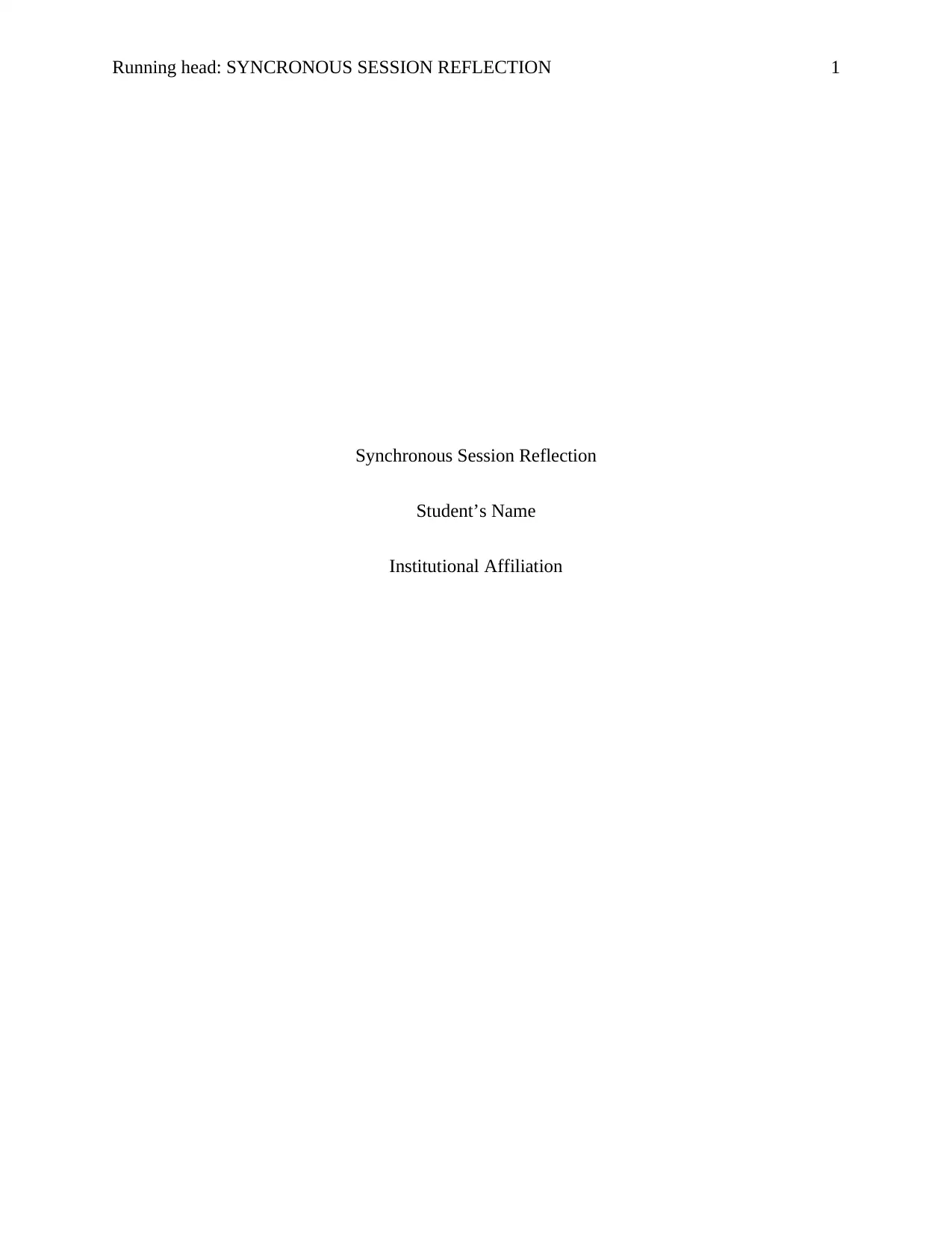
Running head: SYNCRONOUS SESSION REFLECTION 1
Synchronous Session Reflection
Student’s Name
Institutional Affiliation
Synchronous Session Reflection
Student’s Name
Institutional Affiliation
Secure Best Marks with AI Grader
Need help grading? Try our AI Grader for instant feedback on your assignments.
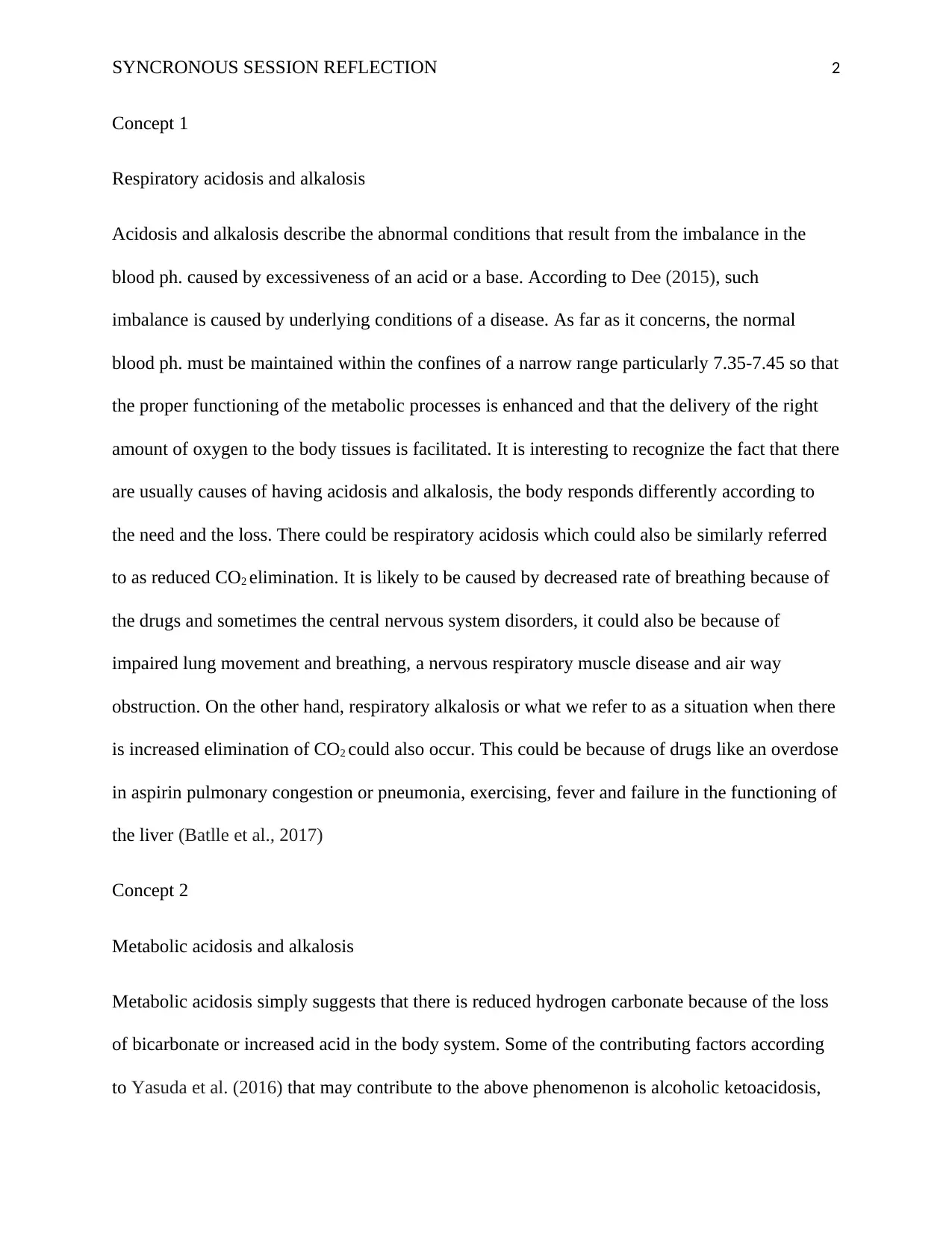
SYNCRONOUS SESSION REFLECTION 2
Concept 1
Respiratory acidosis and alkalosis
Acidosis and alkalosis describe the abnormal conditions that result from the imbalance in the
blood ph. caused by excessiveness of an acid or a base. According to Dee (2015), such
imbalance is caused by underlying conditions of a disease. As far as it concerns, the normal
blood ph. must be maintained within the confines of a narrow range particularly 7.35-7.45 so that
the proper functioning of the metabolic processes is enhanced and that the delivery of the right
amount of oxygen to the body tissues is facilitated. It is interesting to recognize the fact that there
are usually causes of having acidosis and alkalosis, the body responds differently according to
the need and the loss. There could be respiratory acidosis which could also be similarly referred
to as reduced CO2 elimination. It is likely to be caused by decreased rate of breathing because of
the drugs and sometimes the central nervous system disorders, it could also be because of
impaired lung movement and breathing, a nervous respiratory muscle disease and air way
obstruction. On the other hand, respiratory alkalosis or what we refer to as a situation when there
is increased elimination of CO2 could also occur. This could be because of drugs like an overdose
in aspirin pulmonary congestion or pneumonia, exercising, fever and failure in the functioning of
the liver (Batlle et al., 2017)
Concept 2
Metabolic acidosis and alkalosis
Metabolic acidosis simply suggests that there is reduced hydrogen carbonate because of the loss
of bicarbonate or increased acid in the body system. Some of the contributing factors according
to Yasuda et al. (2016) that may contribute to the above phenomenon is alcoholic ketoacidosis,
Concept 1
Respiratory acidosis and alkalosis
Acidosis and alkalosis describe the abnormal conditions that result from the imbalance in the
blood ph. caused by excessiveness of an acid or a base. According to Dee (2015), such
imbalance is caused by underlying conditions of a disease. As far as it concerns, the normal
blood ph. must be maintained within the confines of a narrow range particularly 7.35-7.45 so that
the proper functioning of the metabolic processes is enhanced and that the delivery of the right
amount of oxygen to the body tissues is facilitated. It is interesting to recognize the fact that there
are usually causes of having acidosis and alkalosis, the body responds differently according to
the need and the loss. There could be respiratory acidosis which could also be similarly referred
to as reduced CO2 elimination. It is likely to be caused by decreased rate of breathing because of
the drugs and sometimes the central nervous system disorders, it could also be because of
impaired lung movement and breathing, a nervous respiratory muscle disease and air way
obstruction. On the other hand, respiratory alkalosis or what we refer to as a situation when there
is increased elimination of CO2 could also occur. This could be because of drugs like an overdose
in aspirin pulmonary congestion or pneumonia, exercising, fever and failure in the functioning of
the liver (Batlle et al., 2017)
Concept 2
Metabolic acidosis and alkalosis
Metabolic acidosis simply suggests that there is reduced hydrogen carbonate because of the loss
of bicarbonate or increased acid in the body system. Some of the contributing factors according
to Yasuda et al. (2016) that may contribute to the above phenomenon is alcoholic ketoacidosis,
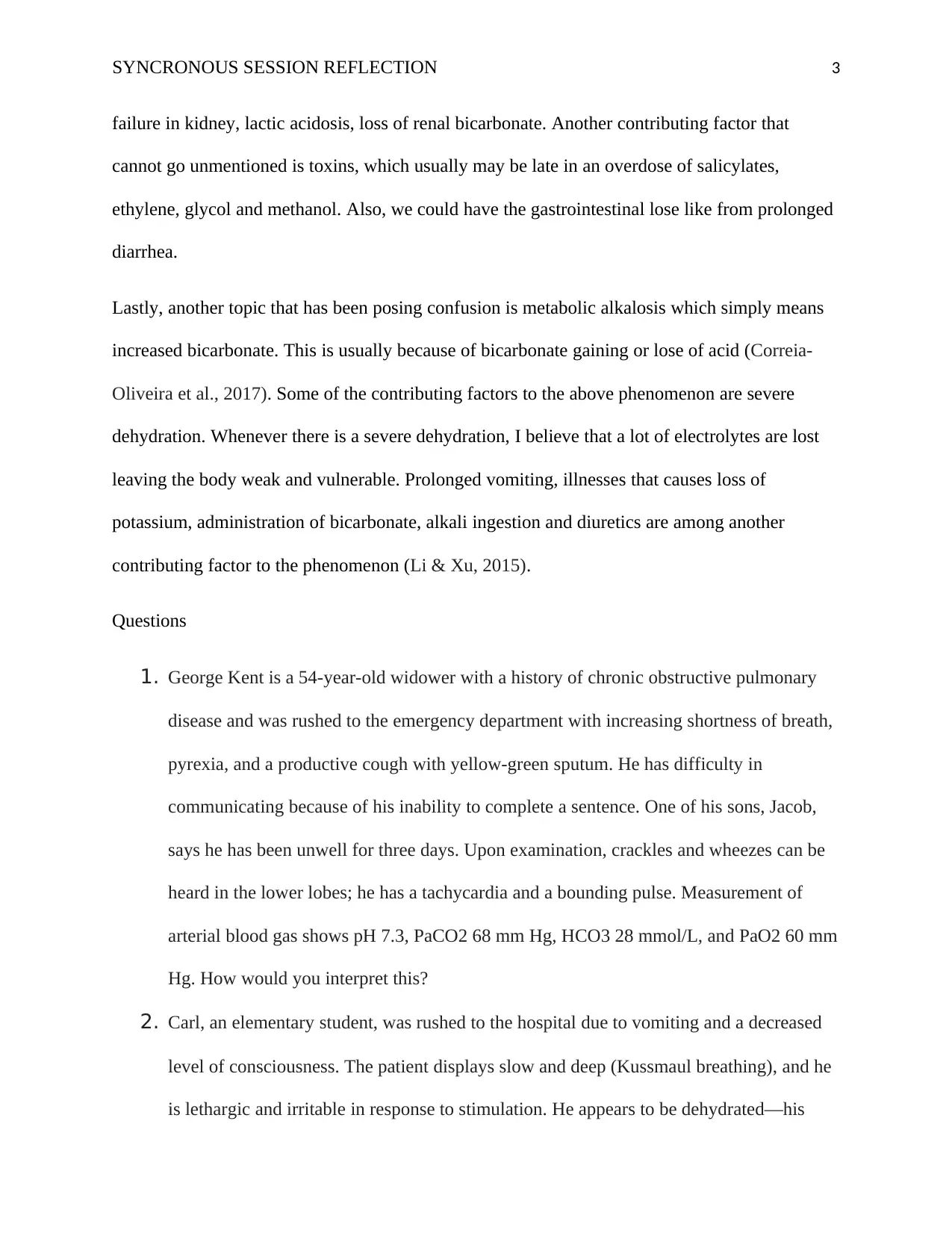
SYNCRONOUS SESSION REFLECTION 3
failure in kidney, lactic acidosis, loss of renal bicarbonate. Another contributing factor that
cannot go unmentioned is toxins, which usually may be late in an overdose of salicylates,
ethylene, glycol and methanol. Also, we could have the gastrointestinal lose like from prolonged
diarrhea.
Lastly, another topic that has been posing confusion is metabolic alkalosis which simply means
increased bicarbonate. This is usually because of bicarbonate gaining or lose of acid (Correia-
Oliveira et al., 2017). Some of the contributing factors to the above phenomenon are severe
dehydration. Whenever there is a severe dehydration, I believe that a lot of electrolytes are lost
leaving the body weak and vulnerable. Prolonged vomiting, illnesses that causes loss of
potassium, administration of bicarbonate, alkali ingestion and diuretics are among another
contributing factor to the phenomenon (Li & Xu, 2015).
Questions
1. George Kent is a 54-year-old widower with a history of chronic obstructive pulmonary
disease and was rushed to the emergency department with increasing shortness of breath,
pyrexia, and a productive cough with yellow-green sputum. He has difficulty in
communicating because of his inability to complete a sentence. One of his sons, Jacob,
says he has been unwell for three days. Upon examination, crackles and wheezes can be
heard in the lower lobes; he has a tachycardia and a bounding pulse. Measurement of
arterial blood gas shows pH 7.3, PaCO2 68 mm Hg, HCO3 28 mmol/L, and PaO2 60 mm
Hg. How would you interpret this?
2. Carl, an elementary student, was rushed to the hospital due to vomiting and a decreased
level of consciousness. The patient displays slow and deep (Kussmaul breathing), and he
is lethargic and irritable in response to stimulation. He appears to be dehydrated—his
failure in kidney, lactic acidosis, loss of renal bicarbonate. Another contributing factor that
cannot go unmentioned is toxins, which usually may be late in an overdose of salicylates,
ethylene, glycol and methanol. Also, we could have the gastrointestinal lose like from prolonged
diarrhea.
Lastly, another topic that has been posing confusion is metabolic alkalosis which simply means
increased bicarbonate. This is usually because of bicarbonate gaining or lose of acid (Correia-
Oliveira et al., 2017). Some of the contributing factors to the above phenomenon are severe
dehydration. Whenever there is a severe dehydration, I believe that a lot of electrolytes are lost
leaving the body weak and vulnerable. Prolonged vomiting, illnesses that causes loss of
potassium, administration of bicarbonate, alkali ingestion and diuretics are among another
contributing factor to the phenomenon (Li & Xu, 2015).
Questions
1. George Kent is a 54-year-old widower with a history of chronic obstructive pulmonary
disease and was rushed to the emergency department with increasing shortness of breath,
pyrexia, and a productive cough with yellow-green sputum. He has difficulty in
communicating because of his inability to complete a sentence. One of his sons, Jacob,
says he has been unwell for three days. Upon examination, crackles and wheezes can be
heard in the lower lobes; he has a tachycardia and a bounding pulse. Measurement of
arterial blood gas shows pH 7.3, PaCO2 68 mm Hg, HCO3 28 mmol/L, and PaO2 60 mm
Hg. How would you interpret this?
2. Carl, an elementary student, was rushed to the hospital due to vomiting and a decreased
level of consciousness. The patient displays slow and deep (Kussmaul breathing), and he
is lethargic and irritable in response to stimulation. He appears to be dehydrated—his
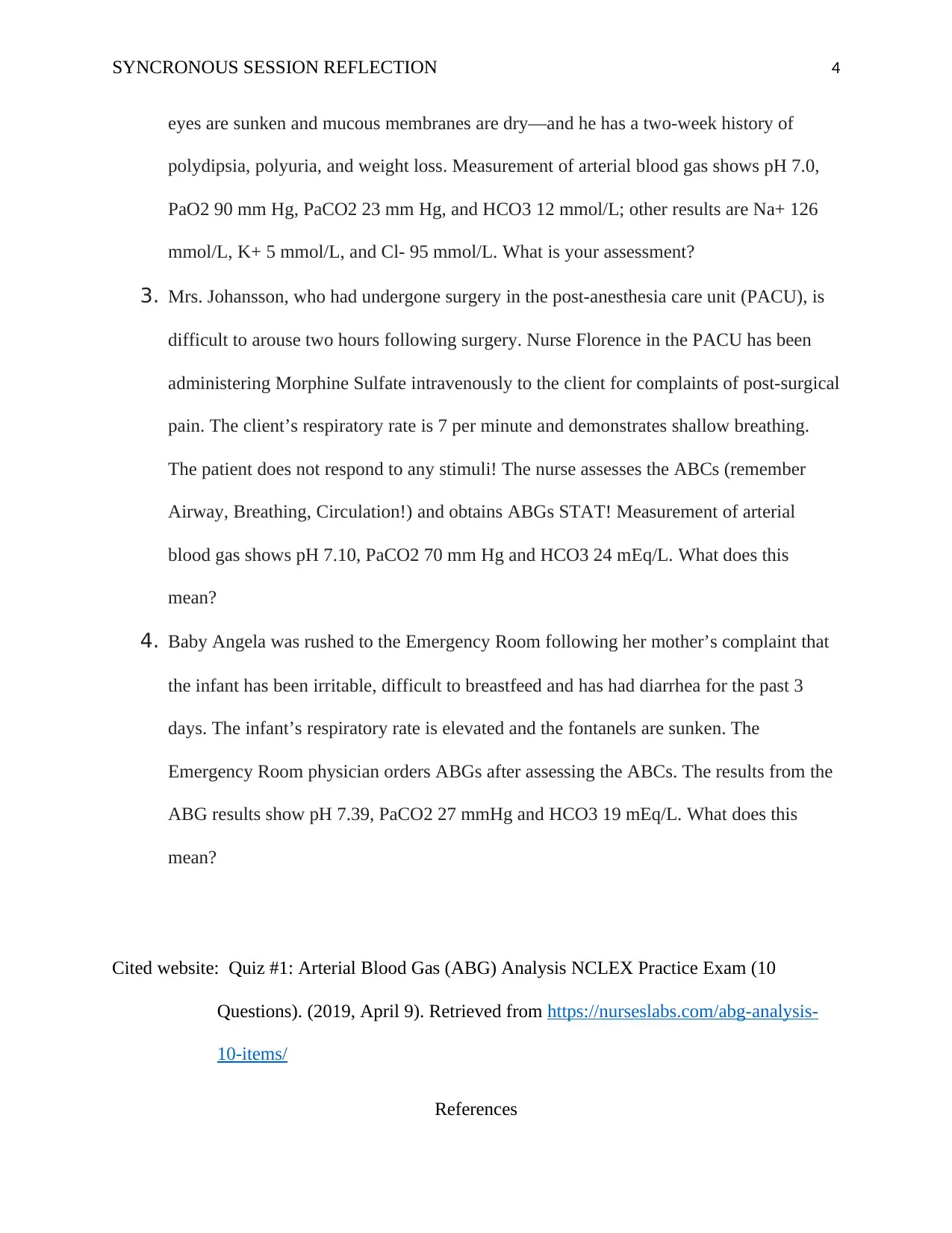
SYNCRONOUS SESSION REFLECTION 4
eyes are sunken and mucous membranes are dry—and he has a two-week history of
polydipsia, polyuria, and weight loss. Measurement of arterial blood gas shows pH 7.0,
PaO2 90 mm Hg, PaCO2 23 mm Hg, and HCO3 12 mmol/L; other results are Na+ 126
mmol/L, K+ 5 mmol/L, and Cl- 95 mmol/L. What is your assessment?
3. Mrs. Johansson, who had undergone surgery in the post-anesthesia care unit (PACU), is
difficult to arouse two hours following surgery. Nurse Florence in the PACU has been
administering Morphine Sulfate intravenously to the client for complaints of post-surgical
pain. The client’s respiratory rate is 7 per minute and demonstrates shallow breathing.
The patient does not respond to any stimuli! The nurse assesses the ABCs (remember
Airway, Breathing, Circulation!) and obtains ABGs STAT! Measurement of arterial
blood gas shows pH 7.10, PaCO2 70 mm Hg and HCO3 24 mEq/L. What does this
mean?
4. Baby Angela was rushed to the Emergency Room following her mother’s complaint that
the infant has been irritable, difficult to breastfeed and has had diarrhea for the past 3
days. The infant’s respiratory rate is elevated and the fontanels are sunken. The
Emergency Room physician orders ABGs after assessing the ABCs. The results from the
ABG results show pH 7.39, PaCO2 27 mmHg and HCO3 19 mEq/L. What does this
mean?
Cited website: Quiz #1: Arterial Blood Gas (ABG) Analysis NCLEX Practice Exam (10
Questions). (2019, April 9). Retrieved from https://nurseslabs.com/abg-analysis-
10-items/
References
eyes are sunken and mucous membranes are dry—and he has a two-week history of
polydipsia, polyuria, and weight loss. Measurement of arterial blood gas shows pH 7.0,
PaO2 90 mm Hg, PaCO2 23 mm Hg, and HCO3 12 mmol/L; other results are Na+ 126
mmol/L, K+ 5 mmol/L, and Cl- 95 mmol/L. What is your assessment?
3. Mrs. Johansson, who had undergone surgery in the post-anesthesia care unit (PACU), is
difficult to arouse two hours following surgery. Nurse Florence in the PACU has been
administering Morphine Sulfate intravenously to the client for complaints of post-surgical
pain. The client’s respiratory rate is 7 per minute and demonstrates shallow breathing.
The patient does not respond to any stimuli! The nurse assesses the ABCs (remember
Airway, Breathing, Circulation!) and obtains ABGs STAT! Measurement of arterial
blood gas shows pH 7.10, PaCO2 70 mm Hg and HCO3 24 mEq/L. What does this
mean?
4. Baby Angela was rushed to the Emergency Room following her mother’s complaint that
the infant has been irritable, difficult to breastfeed and has had diarrhea for the past 3
days. The infant’s respiratory rate is elevated and the fontanels are sunken. The
Emergency Room physician orders ABGs after assessing the ABCs. The results from the
ABG results show pH 7.39, PaCO2 27 mmHg and HCO3 19 mEq/L. What does this
mean?
Cited website: Quiz #1: Arterial Blood Gas (ABG) Analysis NCLEX Practice Exam (10
Questions). (2019, April 9). Retrieved from https://nurseslabs.com/abg-analysis-
10-items/
References
Secure Best Marks with AI Grader
Need help grading? Try our AI Grader for instant feedback on your assignments.
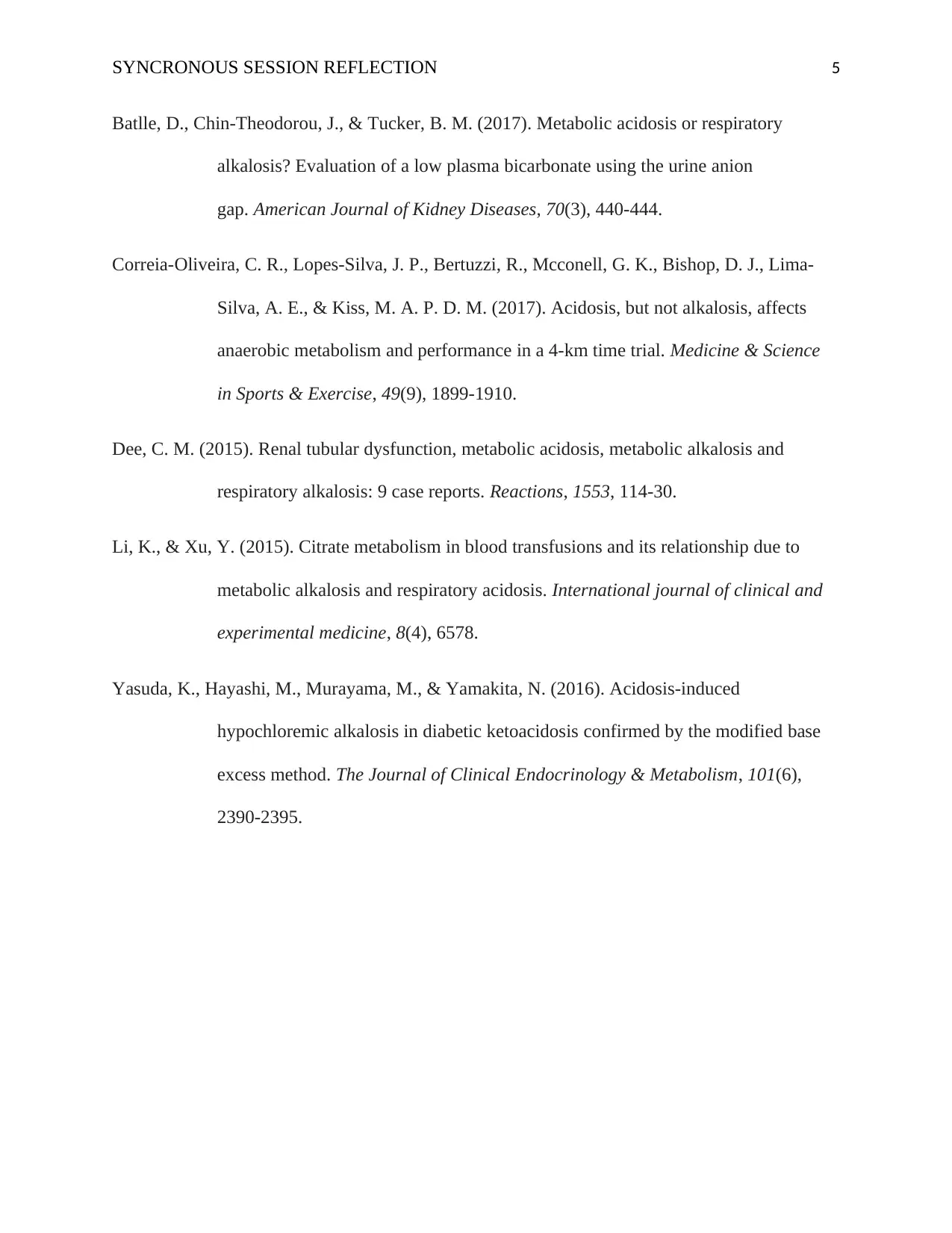
SYNCRONOUS SESSION REFLECTION 5
Batlle, D., Chin-Theodorou, J., & Tucker, B. M. (2017). Metabolic acidosis or respiratory
alkalosis? Evaluation of a low plasma bicarbonate using the urine anion
gap. American Journal of Kidney Diseases, 70(3), 440-444.
Correia-Oliveira, C. R., Lopes-Silva, J. P., Bertuzzi, R., Mcconell, G. K., Bishop, D. J., Lima-
Silva, A. E., & Kiss, M. A. P. D. M. (2017). Acidosis, but not alkalosis, affects
anaerobic metabolism and performance in a 4-km time trial. Medicine & Science
in Sports & Exercise, 49(9), 1899-1910.
Dee, C. M. (2015). Renal tubular dysfunction, metabolic acidosis, metabolic alkalosis and
respiratory alkalosis: 9 case reports. Reactions, 1553, 114-30.
Li, K., & Xu, Y. (2015). Citrate metabolism in blood transfusions and its relationship due to
metabolic alkalosis and respiratory acidosis. International journal of clinical and
experimental medicine, 8(4), 6578.
Yasuda, K., Hayashi, M., Murayama, M., & Yamakita, N. (2016). Acidosis-induced
hypochloremic alkalosis in diabetic ketoacidosis confirmed by the modified base
excess method. The Journal of Clinical Endocrinology & Metabolism, 101(6),
2390-2395.
Batlle, D., Chin-Theodorou, J., & Tucker, B. M. (2017). Metabolic acidosis or respiratory
alkalosis? Evaluation of a low plasma bicarbonate using the urine anion
gap. American Journal of Kidney Diseases, 70(3), 440-444.
Correia-Oliveira, C. R., Lopes-Silva, J. P., Bertuzzi, R., Mcconell, G. K., Bishop, D. J., Lima-
Silva, A. E., & Kiss, M. A. P. D. M. (2017). Acidosis, but not alkalosis, affects
anaerobic metabolism and performance in a 4-km time trial. Medicine & Science
in Sports & Exercise, 49(9), 1899-1910.
Dee, C. M. (2015). Renal tubular dysfunction, metabolic acidosis, metabolic alkalosis and
respiratory alkalosis: 9 case reports. Reactions, 1553, 114-30.
Li, K., & Xu, Y. (2015). Citrate metabolism in blood transfusions and its relationship due to
metabolic alkalosis and respiratory acidosis. International journal of clinical and
experimental medicine, 8(4), 6578.
Yasuda, K., Hayashi, M., Murayama, M., & Yamakita, N. (2016). Acidosis-induced
hypochloremic alkalosis in diabetic ketoacidosis confirmed by the modified base
excess method. The Journal of Clinical Endocrinology & Metabolism, 101(6),
2390-2395.
1 out of 5
Your All-in-One AI-Powered Toolkit for Academic Success.
+13062052269
info@desklib.com
Available 24*7 on WhatsApp / Email
![[object Object]](/_next/static/media/star-bottom.7253800d.svg)
Unlock your academic potential
© 2024 | Zucol Services PVT LTD | All rights reserved.



